Fred Harvey Company from
Wikapedia
The Fred Harvey Company was the owner of the Harvey House
chain of restaurants, hotels, and other hospitality industry businesses
alongside railroads in the western United States. The company traces its
origins to the 1875 opening of two railroad eating houses located at Wallace,
Kansas and Hugo, Colorado on the Kansas Pacific Railway. These cafés
were opened by Fred Harvey, then a freight agent for the Chicago, Burlington
& Quincy Railroad. The café operation ended within a year, but
Harvey had been convinced of the potential profits from providing a high
quality food and service at railroad eating houses. His longtime employer,
the Burlington Railroad, declined his offer of establishing a system-wide
eating house operation at all railroad meal stops, but the Atchison, Topeka
& Santa Fe Railway (AT&SF) subsequently contracted with Harvey
for several eating houses on an experimental basis.
In 1878, Harvey started the first of his eating house-hotel
establishments along the AT&SF tracks in Florence, Kansas. The rapid
growth of the Harvey House chain soon followed.
Fred Harvey is credited with creating the first restaurant
chain in the U.S. Harvey and his company also became leaders in promoting
tourism in the American Southwest in the late 19th century. The company
and its employees, including the famous waitresses who came to be known
as Harvey Girls, successfully brought new higher standards of both civility
and dining to a region widely regarded in the era as "the Wild West". The
popularity of the Harvey Girls grew even stronger in 1946 when Judy Garland
starred in the film version of Samuel Hopkins Adamss novel The Harvey
Girls.
Despite the decline of passenger train patronage in the
U.S. in the 20th century with the advent of the automobile, the company
survived and prospered, by marketing its services to the motoring public.
After 1926, Harvey Cars were used in the provision of "Indian Detours"
services offered from a number of Harvey hotel locations. The company continued
to adjust to the trends. In the late 1950s it operated, for the first 15
years, the then-new landmark Illinois Tollway "Oases" which were built
above the Interstate 294 highway in the Chicago suburbs by Standard Oil
of Indiana (Amoco).
The Fred Harvey legacy was continued in the family until
the death of a grandson in 1965. Portions of the Fred Harvey Company have
continued to operate since 1968 as part of a larger hospitality industry
conglomerate.
History
Before the inclusion of dining cars in passenger trains
became common practice, a rail passenger's only option for meal service
in transit was to patronize one of the roadhouses often located near the
railroad's water stops. Fare typically consisted of nothing more than rancid
meat, cold beans, and week-old coffee. Such poor conditions understandably
discouraged many Americans from making the journey westward.
The subsequent growth and development of the Fred Harvey
Company was closely related to that of AT&SF. Under the terms of an
oral agreement, Harvey opened his first depot restaurant in Topeka, Kansas
in January 1876. Railroad officials and passengers alike were impressed
with Fred Harvey's strict standards for high quality food and first class
service. As a result, AT&SF entered into subsequent contracts with
Harvey wherein he was given unlimited funds to set up a series of what
were dubbed "eating houses" along most of the route. At more prominent
locations, these eating houses evolved into hotels, many of which survive
today. By the late 1880s, there was a Fred Harvey dining facility located
every 100 miles along the AT&SF.
AT&SF agreed to convey fresh meat and produce free-of-charge
to any Harvey House via its own private line of refrigerator cars, the
Santa Fe Refrigerator Despatch, and in them food was shipped |
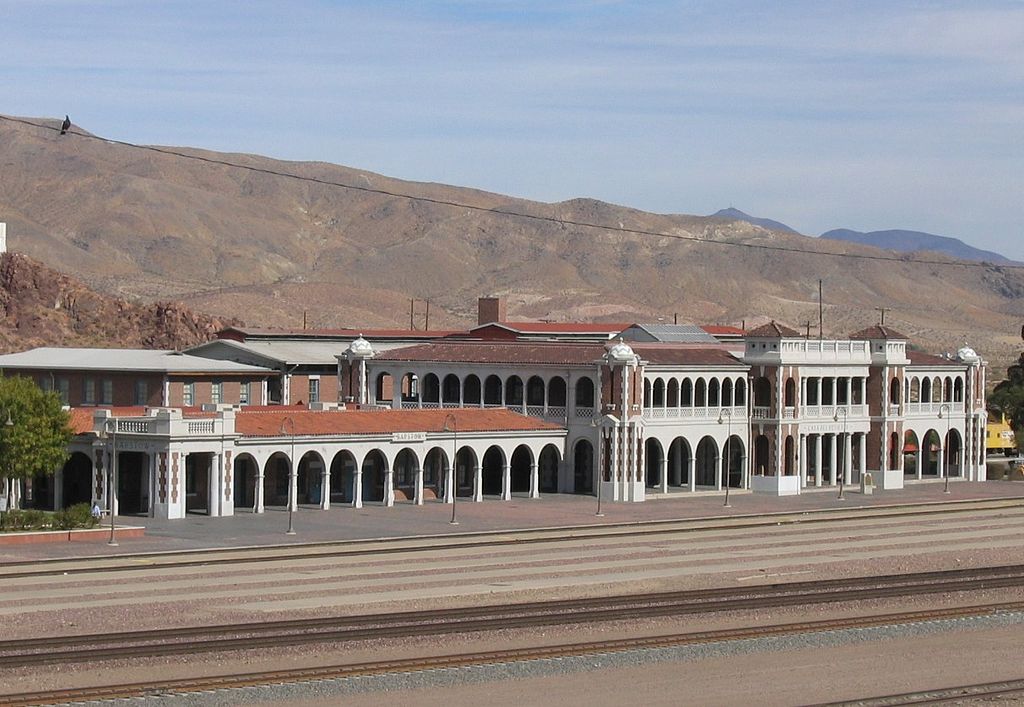
The Casa del Desierto
("House of the Desert")
located in Barstow, California,
is seen here in 2006.
The Spanish-Moroccan designed structure
took two years to construct, and
opened its doors on February 22, 1911.
The building has been designated as a
California Historical Landmark, #892.
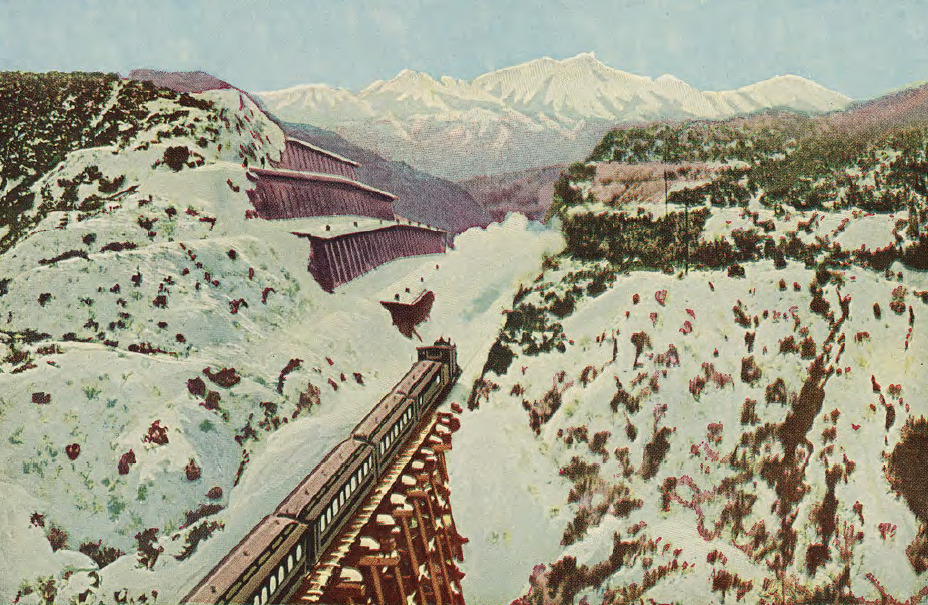
Cajon summit and the Santa Fe Railroad,
c. 1919. From a Fred Harvey Co.
tourist brochure.
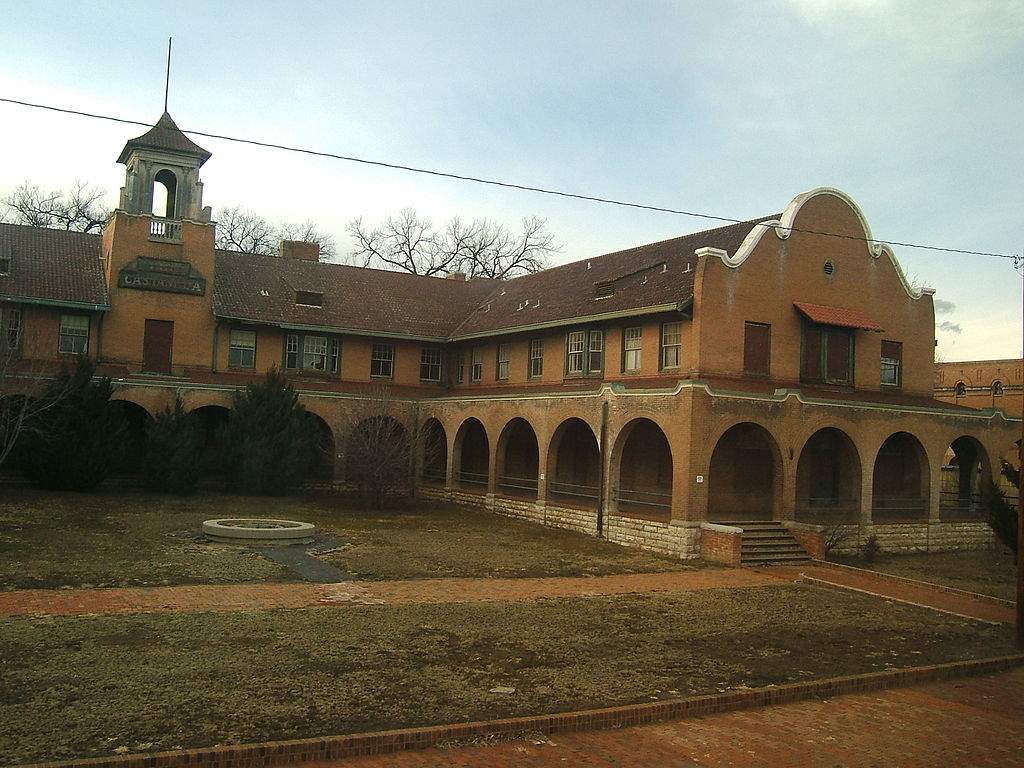
The Hotel Castañeda, Las Vegas,
New Mexico as seen in 2007.
An early mission revival style
Harvey House (1899)
and sister hotel to the Alvarado in
Albuquerque, New Mexico.
|
from every corner of the U.S. The company maintained two
dairy facilities (the larger of the two was situated in Las Vegas, New
Mexico) to ensure a consistent and adequate supply of fresh milk. When
dining cars began to appear on trains, AT&SF contracted with the Fred
Harvey Company to operate the food service on the diners, and all AT&SF
advertising proclaimed "Fred Harvey Meals All the Way".
Harvey's meals were served in sumptuous portions that
provided a good value for the traveling public; for instance, pies were
cut into fourths, rather than sixths, which was the industry standard at
the time. The Harvey Company and AT&SF established a series of signals
that allowed the dining room staff to make the necessary preparations to
feed an entire train in just thirty minutes. Harvey Houses served their
meals on fine China and Irish linens. Fred Harvey, a fastidious innkeeper,
set high standards for efficiency and cleanliness in his establishments,
personally inspecting them as often as possible. It was said that nothing
escaped his notice, and he was even known to completely overturn a poorly
set table. Male customers were required to wear a coat and tie in many
of Harvey's dining rooms. The Harvey Houses served many a meal to GIs traveling
on troop trains during World War II.
This mutually beneficial relationship, characterized as
one of the most successful and influential business partnerships in the
early American West, endured until 1963.
Facilities
For the Southwest, Harvey hired architects Charles Whittlesey
and designer Mary Colter for influential landmark hotels in Santa Fe and
Gallup, New Mexico. The Grand Canyon was the Santa Fe's main tourist destination
and a major activity of the Harvey Company. Colter's rugged, landscape-integrated,
and culturally appropriate design principles there influenced a generation
of subsequent Western U.S. architecture through the National Park Service
and Civilian Conservation Corps structures built during the Great Depression
and after.
The Harvey team, with the backing of the Santa Fe, created
an entire set of cultural images based on the region's distinctive, and
often overlooked, artistic traditions of the Native American residents
and the early Spanish settlers in the area. A pioneer in the field, Mary
Colter designed a number of lobbies, restaurants, sales rooms, and other
public spaces for the Santa Fe facilities. Especially noteworthy were Colter's
buildings on the South Rim of the Grand Canyon, including lodges, souvenirs
shops, and special lookout points, today on the National Register of Historic
Places.
A rare woman architect in her day, Colter came to design
complete hotels along the Santa Fe's main route. She was the architect
for the 1930 La Posada Hotel in Winslow, Arizona, called "the last great
railroad hotel built in America".
Colter's work with the Santa Fe, the National Park Service,
and the Harvey Company blended Pueblo Revival, Mission Revival, Spanish
Colonial Revival, and Rustic architectural styles along with Mexican carved-wood
and hand-painted furnishings and Native American artistic motifs to help
create a style widely popular in the American Southwest.
The last of her big projects was the Harvey House in the
1939 Los Angeles Union Station, dominated by a block-long recreation of
a Navajo rug rendered in linoleum floor tile.
It has been suggested that the Harvey Houses originated
the "blue-plate special", a daily low-priced complete meal served on a
blue-patterned china plate; an 1892 Harvey menu mentions them, some thirty
years before the term became widespread. In addition to the AT&SF,
the Harvey Company operated dining facilities for the Gulf Coast &
Santa Fe, Kansas Pacific, St. Louis-San Francisco, and the Terminal Railroad
Association of St. Louis railways.
AT&SF maintained and operated a fleet of three passenger
ferry boats that connected the railroad with San Francisco by water. Ships
traveled the eight miles between the San Francisco Ferry Terminal and the
railroad's Point Richmond terminal across the Bay. The service was originally
established as a continuation of the company's named passenger train runs
such as the Angel and the Saint. The larger two ships, the San Pablo and
the San Pedro, each featured a newsstand-lunch counter located on the main
deck, and a dining room on the upper deck. Meals, sandwiches, sweet rolls,
pastries, and coffee were served. AT&SF discontinued ferry service
in 1933 due to the effects of the Great Depression.
Harvey Girls
| In 1883, Harvey implemented a policy of employing a female,
white-only serving staff. He sought single, well-mannered, and educated
American ladies, and placed ads in newspapers throughout the East Coast
and Midwest for "white, young women, 18-30 years of age, of good character,
attractive and intelligent". The girls were paid $17.50 a month (approximately
$450 in 2017 dollars) to start, plus room, board, and gratuity, a generous
income by the standards of the time.
The women were subjected to a strict 10 p.m. curfew, administered
by a senior Harvey Girl who assumed the role and responsibilities of house
mother. The official starched black and white uniform (which was designed
to diminish the female physique) consisted of a skirt that hung no more
than eight inches off the floor, "Elsie" collars, opaque black stockings,
and black shoes. The hair was restrained in a net and tied with a regulation
white ribbon. Makeup of any sort was absolutely prohibited, as was chewing
gum while on duty. Harvey Girls (as they soon came to be known) were required
to enter into a one-year employment contract, and forfeited half their
base pay should they fail to complete the term of service. Marriage was
the most common reason for a girl to terminate her employment.
The restrictions maintained the clean-cut reputation of
the Harvey Girls, and made them even more marriageable. However, the opportunity
to leave their homes, to enjoy travel, have new experiences, and work outside
the home was very liberating for thousands of young women. After the Harvey
Houses closed in most cities, many former Girls (and today their daughters
and granddaughters) joined in appreciation to carry on their legacy.
In a mythology that has grown around the Harvey Houses,[original
research?] these female employees are said to have helped to "civilize
the American Southwest". This legend found expression in The Harvey Girls,
a 1942 novel by Samuel Hopkins Adams and in the 1946 MGM musical film of
the same name which was inspired by it.
Dining car service
Harvey initially balked at the suggestion that in-transit
dining facilities be added to all AT&SF trains operating west of Kansas
City. Eventually, Harvey agreed to support the railroad in this endeavor,
and the California Limited became the first AT&SF's name trains to
feature Harvey Company meal service en route. Later trains, such as the
vaunted Super Chief, included dining cars (staffed by Fred Harvey Company
personnel) as part of the standard passenger car complement right from
the outset. |
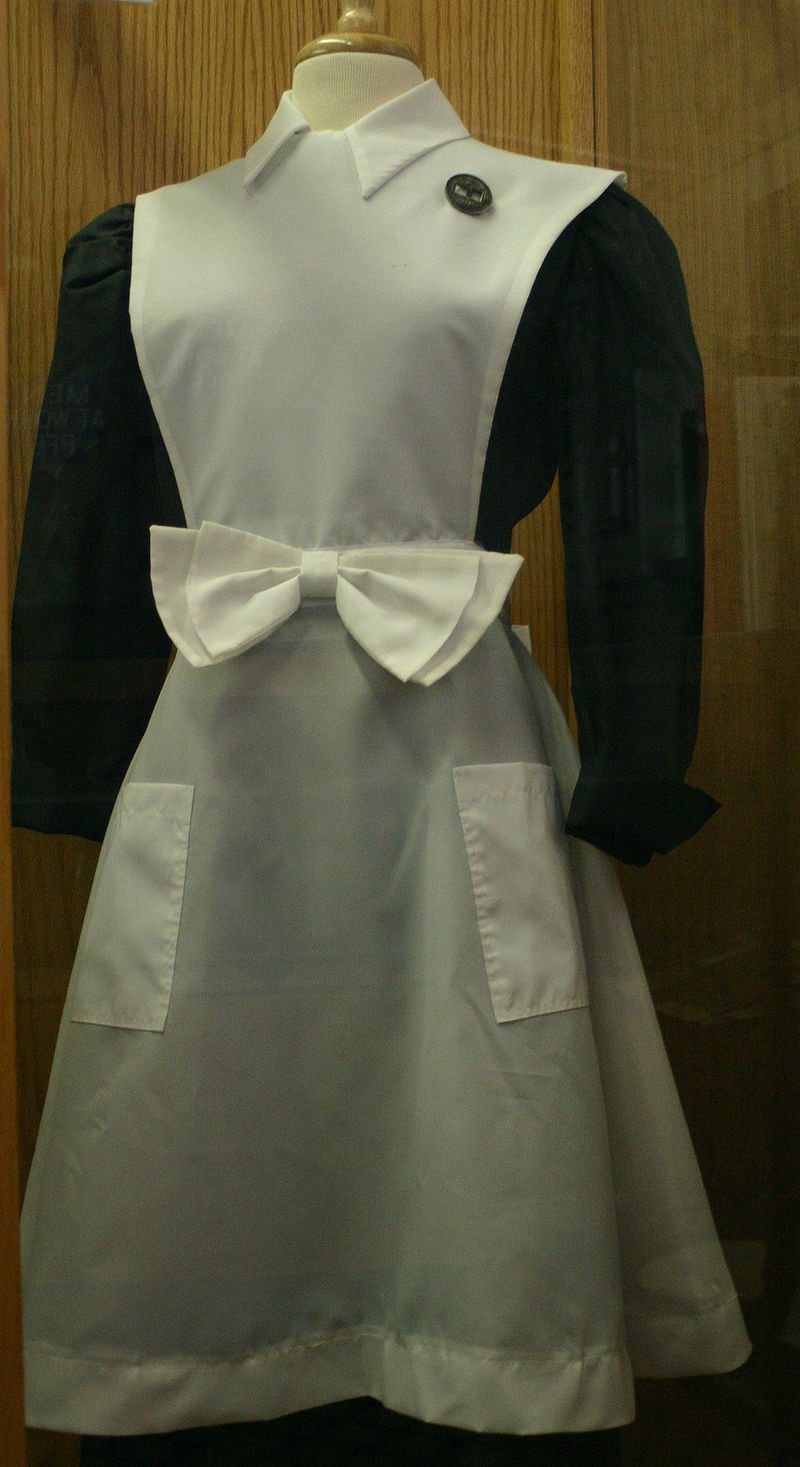
A preserved "Harvey Girl" uniform
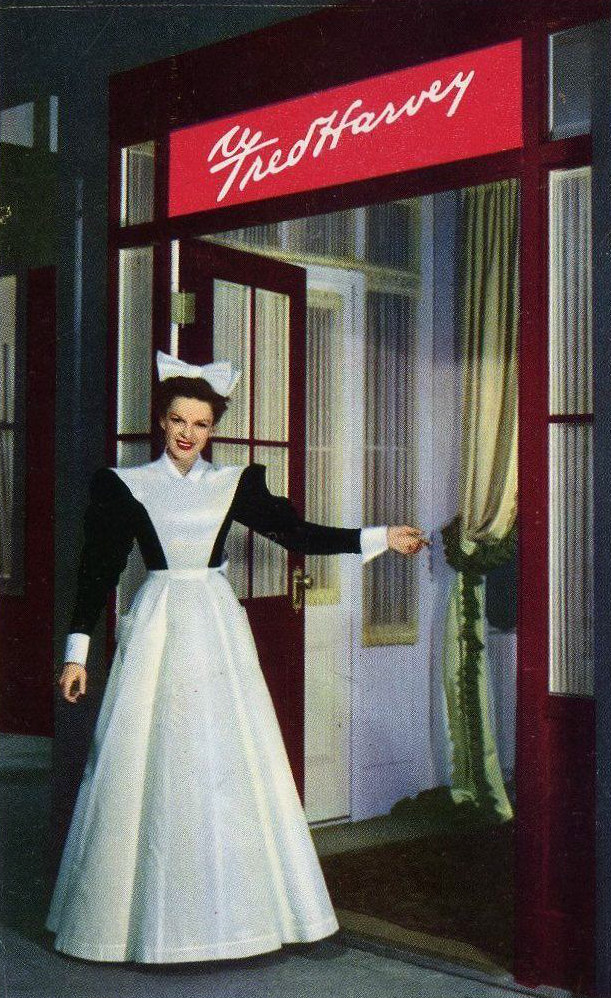
Judy Garland in a scene
from The Harvey Girls.
|
Selected Harvey Hotels
A list of some of the 84 Fred Harvey facilities:
The Alvarado Albuquerque, New Mexico;
closed in 1969, demolished
The Bisonte Hutchinson, Kansas;
closed in 1946
The Casa del Desierto Barstow, California;
closed in 1959, refurbished 1999, operating as two museums and city offices
The Hotel Castañeda Las Vegas,
New Mexico; closed in 1948, used in the 1984 film Red Dawn, purchased for
restoration April 2014
El Garces Needles, California; closed
in 1958, restored in 2014
El Navajo Gallup, New Mexico; demolished
1957
El Ortiz Lamy, New Mexico; closed
in 1938
El Otero La Junta, Colorado; closed
in 1948
El Tovar Grand Canyon, Arizona;
still in operation
El Vaquero Dodge City, Kansas; closed
in 1948
The Havasu House Seligman, Arizona;
closed in 1955, demolished 2008
The Escalante Ash Fork, Arizona;
closed in 1948, demolished in the 1970s
The Fray Marcos Williams, Arizona;
the site is now The Grand Canyon Railway Hotel, designed to resemble the
century-old depot that
housed the original Fray Marcos
La Fonda Santa Fe, New Mexico; acquired
by the Santa Fe Railway, leased to Fred Harvey in 1925; in operation, different
owners
Las Chavez Vaughn, New Mexico; closed
in 1936
La Posada Winslow, Arizona; closed
in 1957; restored and reopened as a historic hotel
The Sequoyah Syracuse, Kansas; closed
in 1936
The Slaton Harvey House Slaton,
Texas; opened in 1912, restaurant closed in 1942, remained train depot
before closing, went into
disrepair and was to be demolished,
was saved by a few locals, renovated, and reopened - currently in operation
as an event center and bed
& breakfast
Los Angeles Union Station Harvey House,
soon to be restored as a gastropub
Separation from AT&SF
Beginning in the 1930s, the Fred Harvey Company began
expanding into other locations beyond the reach of AT&SF, and often
away from rail passenger routes. Restaurants were opened in such locations
as the Chicago Union Station (the largest facility operated by Harvey),
San Diego Union Station, the San Francisco Bus Terminal, and the Albuquerque
International Airport; the last of these was established at the Los Angeles
Union Passenger Terminal in 1939, and could accommodate nearly 300 diners.
From 1959 until 1975, the Fred Harvey organization operated
a series of restaurants in the Illinois Tollway oasis, a set of highway
rest stops built on bridges over the tollway. The original Fred Harvey
company, as well as the company's close affiliation with AT&SF, lasted
until 1968 when it was purchased by the Amfac Corporation of Hawaii. Amfac
was renamed Xanterra Parks & Resorts in 2002. In 2006, Xanterra purchased
the Grand Canyon Railway and its properties.
|
| Mules from Wikapedia
A mule is the offspring of a male donkey (jack) and a
female horse (mare). Horses and donkeys are different species, with different
numbers of chromosomes. Of the two F1 hybrids (first generation hybrids)
between these two species, a mule is easier to obtain than a hinny, which
is the offspring of a female donkey (jenny) and a male horse (stallion).
The size of a mule and work to which it is put depend
largely on the breeding of the mule's female parent (dam). Mules can be
lightweight, medium weight, or when produced from draft horse mares, of
moderately heavy weight. Mules are more patient, hardy and long-lived than
horses, and are less obstinate and more intelligent than donkeys.
Biology
The mule is valued because, while it has the size and
ground-covering ability of its dam, it is stronger than a horse of similar
size and inherits the endurance and disposition of the donkey sire, tending
to require less food than a horse of similar size. Mules also tend to be
more independent than most domesticated equines other than the donkey.
The median weight range for a mule is between about 370
and 460 kg (820 and 1,000 lb). While a few mules can carry live weight
up to 160 kg (353 lb), the superiority of the mule becomes apparent in
their additional endurance.
In general, a mule can be packed with dead weight of up
to 20% of its body weight, or approximately 90 kg (198 lb). Although it
depends on the individual animal, it has been reported that mules trained
by the Army of Pakistan can carry up to 72 kilograms (159 lb) and walk
26 kilometres (16.2 mi) without resting. The average equine in general
can carry up to approximately 30% of its body weight in live weight, such
as a rider.
A female mule that has estrus cycles and thus, in theory,
could carry a fetus, is called a "molly" or "Molly mule", though the term
is sometimes used to refer to female mules in general. Pregnancy is rare,
but can occasionally occur naturally as well as through embryo transfer.
A male mule is properly called a horse mule, though often called a john
mule, which is the correct term for a gelded mule. A young male mule is
called a mule colt, and a young female is called a mule filly.
Characteristics
With its short thick head, long ears, thin limbs, small
narrow hooves, and short mane, the mule shares characteristics of a donkey.
In height and body, shape of neck and rump, uniformity of coat, and teeth,
it appears horse-like. The mule comes in all sizes, shapes and conformations.
There are mules that resemble huge draft horses, sturdy quarter horses,
fine-boned racing horses, shaggy ponies and more.
The mule is an example of hybrid vigor. Charles Darwin
wrote: "The mule always appears to me a most surprising animal. That a
hybrid should possess more reason, memory, obstinacy, social affection,
powers of muscular endurance, and length of life, than either of its parents,
seems to indicate that art has here outdone nature."
The mule inherits from its sire the traits of intelligence,
sure-footedness, toughness, endurance, disposition, and natural cautiousness.
From its dam it inherits speed, conformation, and agility. Mules exhibit
a higher cognitive intelligence than their parent species. This is also
believed to be the result of hybrid vigor, similar to how mules acquire
greater height and endurance than either parent.
Handlers of working animals generally find mules preferable
to horses: mules show more patience under the pressure of heavy weights,
and their skin is harder and less sensitive than that of horses, rendering
them more capable of resisting sun and rain. Their hooves are harder than
horses', and they show a natural resistance to disease and insects. Many
North American farmers with clay soil found mules superior as plow animals.
A mule does not sound exactly like a donkey or a horse.
Instead, a mule makes a sound that is similar to a donkey's but also has
the whinnying characteristics of a horse (often starts with a whinny, ends
in a hee-haw). Mules sometimes whimper.
Color and size variety
Mules come in a variety of shapes, sizes and colors, from
minis under 50 lb (23 kg) to maxis over 1,000 lb (454 kg), and in many
different colors. The coats of mules come in the same varieties as those
of horses. Common colors are sorrel, bay, black, and grey. Less common
are white, roans (both blue and red), palomino, dun, and buckskin. Least
common are paint mules or tobianos. Mules from Appaloosa mares produce
wildly colored mules, much like their Appaloosa horse relatives, but with
even wilder skewed colors. The Appaloosa color is produced by a complex
of genes known as the Leopard complex (Lp). Mares homozygous for the Lp
gene bred to any color donkey will produce a spotted mule.
| Distribution and use
Mules historically were used by armies to transport supplies,
occasionally as mobile firing platforms for smaller cannons, and to pull
heavier field guns with wheels over mountainous trails such as in Afghanistan
during the Second Anglo-Afghan War.
The Food and Agriculture Organization of the United Nations
(FAO) reports that China was the top market for mules in 2003, closely
followed by Mexico and many Central and South American nations.
Fertility
Mules and hinnies have 63 chromosomes, a mixture of the
horse's 64 and the donkey's 62. The different structure and number usually
prevents the chromosomes from pairing up properly and creating successful
embryos, rendering most mules infertile.
There are no recorded cases of fertile mule stallions.
A few mare mules have |
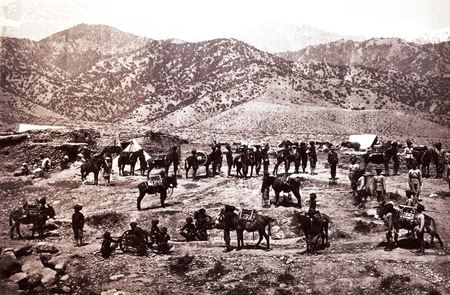
A mule battery in the Second Anglo-Afghan War (18791880).
Sepoys are sitting by the larger field guns. |
produced offspring when mated with a purebred horse
or donkey. Herodotus gives an account of such an event as an ill omen of
Xerxes' invasion of Greece in 480 BC: "There happened also a portent of
another kind while he was still at Sardis,a mule brought forth young and
gave birth to a mule", and a mule's giving birth was a frequently recorded
portent in antiquity, although scientific writers also doubted whether
the thing was really possible.
As of October 2002, there had been only 60 documented
cases of mules birthing foals since 1527. In China in 2001, a mare mule
produced a filly. In Morocco in early 2002 and Colorado in 2007, mare mules
produced colts. Blood and hair samples from the Colorado birth verified
that the mother was indeed a mule and the foal was indeed her offspring.
A 1939 article in the Journal of Heredity describes two
offspring of a fertile mare mule named "Old Bec", which was owned at the
time by the A&M College of Texas (now Texas A&M University) in
the late 1920s. One of the foals was a female, sired by a jack. Unlike
its mother, it was sterile. The other, sired by a five-gaited Saddlebred
stallion, exhibited no characteristics of any donkey. That horse, a stallion,
was bred to several mares, which gave birth to live foals that showed no
characteristics of the donkey.
Modern mules
In the second half of the 20th century, widespread usage
of mules declined in industrialized countries. The use of mules for farming
and transportation of agricultural products largely gave way to modern
tractors and trucks. However, in the United States, a dedicated number
of mule breeders continued the tradition as a hobby and continued breeding
the great lines of American Mammoth Jacks started in the United States
by George Washington with the gift from the King of Spain of two Zamorano-Leonés
donkeys. These hobby breeders began to utilize better mares for mule production
until today's modern saddle mule emerged. Exhibition shows where mules
pulled heavy loads have now been joined with mules competing in Western
and English pleasure riding, as well as dressage and show jumping competition.
There is now a cable TV show dedicated to the training of donkeys and mules.
Mules, once snubbed at traditional horse shows, have been accepted for
competition at the most exclusive horse shows in the world in all disciplines.
Mules are still used extensively to transport cargo in
rugged roadless regions, such as the large wilderness areas of California's
Sierra Nevada mountains or the Pasayten Wilderness of northern Washington
state. Commercial pack mules are used recreationally, such as to supply
mountaineering base camps, and also to supply trail building and maintenance
crews, and backcountry footbridge building crews. As of July 2014, there
are at least sixteen commercial mule pack stations in business in the Sierra
Nevada. The Angeles chapter of the Sierra Club has a Mule Pack Section
that organizes hiking trips with supplies carried by mules.
Amish farmers, who reject tractors and most other modern
technology for religious reasons, commonly use teams of six or eight mules
to pull plows, disk harrows, and other farm equipment, though they use
horses for pulling buggies on the road.
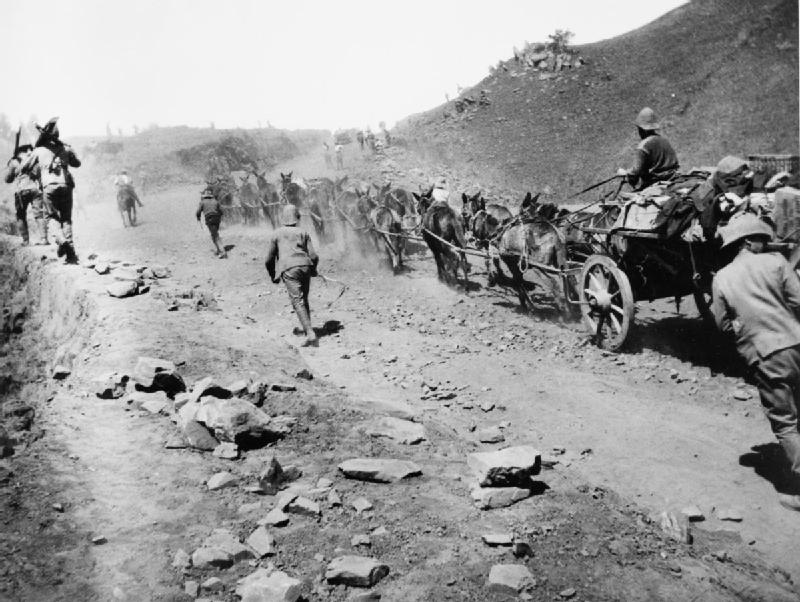
A British mule train during the
Second Anglo-Boer War, South Africa |
During the Soviet war in Afghanistan, the United States
used large numbers of mules to carry weapons and supplies over Afghanistan's
rugged terrain to the mujahideen. Use of mules by U.S. forces has continued
during the War in Afghanistan (2001-present), and the United States Marine
Corps has conducted an 11-day Animal Packers Course since the 1960s at
its Mountain Warfare Training Center located in the Sierra Nevada near
Bridgeport, California.
Mule train
A mule train is a connected or unconnected line of pack
mules, usually carrying cargo. Because of the mule's ability to carry as
much as a horse, their trait of being sure footed along with their tolerance
of poorer coarser foods and abilities to tolerate arid terrains, mule trains
were common caravan organized means of animal powered bulk transport back
into pre-classical times. In many climate and circumstantial instances,
an equivalent string of pack horses would have to carry more fodder and
sacks of high energy grains such as oats, so could carry less cargo. In
modern times, strings of sure footed mules have been used to carry riders
in dangerous but scenic back country terrain such as excursions into canyons.
|
Pack trains were instrumental in opening up the American
West as the sure footed animals could carry up to 250 pounds, survive on
rough forage, did not require feed, and could operate in the arid higher
elevations of the Rockies, serving as the main cargo means to the west
from Missouri during the heyday of the North American fur trade. Their
use antedated the move west into the Rockies as colonial Americans sent
out the first fur trappers and explorers past the Appalachians who were
then followed west by high-risk-taking settlers by the 1750s (such as Daniel
Boone) who led an increasing flood of emigrants that began pushing west
over the into southern New York, and through the gaps of the Allegheny
into the Ohio Country (the lands of western Province of Virginia and the
Province of Pennsylvania), into Tennessee and Kentucky before and especially
after the American Revolution.
Mule trains have been used as working (as opposed to tourist
attractions) portions of transportation links as recently as 2005 by the
World Food Programme.
In the nineteenth century, twenty-mule teams, for instance,
were teams of eighteen mules and two horses attached to large wagons that
ferried borax out of Death Valley from 1883 to 1889. The wagons were among
the largest ever pulled by draft animals, designed to carry 10 short tons
(9 metric tons) of borax ore at a time.
|
.
All articles submitted to the "Brimstone
Gazette" are the property of the author, used with their expressed permission.
The Brimstone Pistoleros are not
responsible for any accidents which may occur from use of loading
data, firearms information, or recommendations published on the Brimstone
Pistoleros web site. |
|